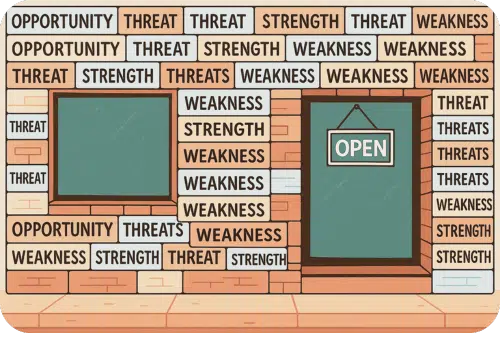Marketing Strategy
What Are the Four Parts of a SWOT Analysis?
Leverage Your Strengths, Tackle Your Weaknesses, and Spot New Opportunities to Outpace Competitors.
RSG Marketing Team 8 Min Read

Key areas reviewed include:
- SWOT Overview
- Strengths
- Weaknesses
- Opportunities
- Threats
- Implementing into your Business
- Competitive Advantage
SWOT Analysis: A Clear Look Inside Your Business
The SWOT analysis is a powerful planning tool used by businesses looking to excel in the competitive business environment.
Performing a SWOT analysis empowers you to identify and leverage your business’s strengths, effectively address and mitigate your weaknesses, find lucrative opportunities, and prepare against potential threats.
SWOT stands for Strengths, Weaknesses, Opportunities, and Threats, and is the four foundational elements crucial to strategic business planning and decision-making.

In an increasingly competitive landscape, fully grasping these four key components of a SWOT analysis can make a significant difference. It lets you understand internal and external factors shaping your business and influencing your market position.
Think of a SWOT analysis as a roadmap guiding you to informed decision-making. It helps you dissect your company’s core aspects, ensuring your business moves confidently forward and is always heading in the right direction.
Today’s marketplace is rapidly evolving, with competition becoming fiercer by the moment. In such an environment, performing a SWOT analysis isn’t just beneficial; it’s essential. It’s about future-proofing your business, staying ahead of competitors, and adapting swiftly to market changes.
But what exactly makes a SWOT analysis so impactful? Let’s explore each component in detail, uncovering how it directly influences your business success, and demonstrate why it’s a critical tool for any business owner aiming for growth and stability.
Understanding What Are The Four Parts of a SWOT Analysis
Strengths
Think of your business as an ecosystem. What makes it flourish? Your strengths are those unique attributes that set you apart from competitors.

Strengths represent everything your business excels at.
Identifying these areas of excellence is essential when performing a SWOT analysis. Successful business owners deeply understand and leverage their strengths to stand out in their markets.
Small, overlooked attributes can become significant competitive advantages if executed well. Perhaps it’s your innovative products or services, a highly dedicated team, or an efficient supply chain that consistently delivers on time.
It could also be your personal touches, giving customers individualized attention and making them feel genuinely valued using personalized email marketing strategies.
Often, strengths lie in subtle yet impactful details. For instance, being a minor player in a niche market isn’t necessarily a limitation; it can instead provide an opportunity to create stronger, more personal customer relationships. A strength that more prominent, stretched-out brands may be unable to deliver.
Taking the time to identify what your business excels at positions you better against competitors. Sometimes, your most minor strengths turn out to be your greatest assets.
Weaknesses
Acknowledging your business’s weaknesses can be challenging, but it’s an essential step towards meaningful growth.

Weaknesses are internal or external factors affecting your business from performing at its best or achieving its goals.
Business owners often struggle to admit their weaknesses, as doing so would be admitting failure at some level. However, it’s the first step in addressing and fixing the issue.
It’s essential to bring in team members across various departments, who can provide valuable insights and opinions. Often, front-line managers are the first to notice issues with a business function or processes. These revelations can unveil overlooked challenges in marketing, technology adoption, or decision-making.
An ineffective marketing strategy might mean your business isn’t reaching the right audience. Effective email marketing deployment strategies can help connect you with customers at the right time. Falling behind on technology or poor management decisions can slow growth and hurt your brand’s reputation.
Great businesses continually self-reflect, honestly assessing and confronting their weaknesses. Remember, identifying a weakness isn’t negative; it’s an opportunity to transform it into a future strength.
Opportunities
Looking for pathways to growth and greater market share?

Opportunities are external factors in the business landscape that can be leveraged to gain a competitive advantage.
Savvy business managers spot opportunities early and quickly, seizing market share and making it difficult for competitors to keep pace. Staying alert to these emerging trends and industry shifts is essential for maintaining your competitive edge.
One prominent opportunity recently is artificial intelligence. AI-driven technologies are enabling businesses to automate routine processes, enhance customer interactions with AI-powered chatbots, and gain deep insights into consumer behavior, significantly improving efficiency and satisfaction better than ever before.
Another critical opportunity involves staying attuned to consumer trends. It’s imperative that decision makers actively monitor emerging markets, new product categories, and successful industry innovations to identify potential areas for growth.
Observing competitors can also reveal valuable opportunities. Analyzing how competitors reach their audience, what marketing channels they use, and which methods they succeed with can help refine your strategy and better connect with your customers.
Identifying these opportunities allows your business to adapt swiftly, meeting consumer needs proactively and effectively before a competitor does.
Threats
While spotting threats often comes naturally, humans are instinctively attuned to danger, it’s critical to define and strategically manage these risks.

Threats represent issues in the external environments that could negatively impact your business and are outside its control.
Obvious threats might include new competition entering your market, economic downturns, or shifts in customer preferences. However, the less apparent threats that can blindside your business are equally crucial, such as cybersecurity breaches, natural disasters, or sudden regulatory changes that increase operating costs.
Effective threat management involves proactively identifying and developing strategies to minimize potential damage. One way to stay ahead of market threats is by conducting a comprehensive Local SEO audit, helping you spot vulnerabilities and competitor movements before they impact your business.
Anticipating these risks rather than reacting after they’ve occurred saves resources and protects your business’s long-term viability.
Ultimately, investing time and resources into understanding and preparing for threats is significantly less costly than managing the aftermath of unexpected disruptions. Proactive threat analysis ensures your business remains resilient, agile, and well-prepared for the future.
How to Use SWOT Analysis in Daily Business Operations

Conducting a SWOT analysis helps you transform strategic insight into actionable decisions. It can inform strategic business decisions such as introducing a new product or service offering, revising pricing strategies, planning counter moves against competitors’ activities, increasing profit, reducing operating costs, and more.
Regularly evaluate your company’s strengths to leverage them effectively, such as using excellent customer service as a differentiating factor in marketing campaigns.
Addressing weaknesses can include regular training to improve team capabilities or improving operations to reduce inefficiencies.
Continuously scan for opportunities by staying informed about industry trends and consumer feedback, enabling timely product development or targeted marketing efforts. For example, if market research indicates a growing interest in sustainable products, quickly integrating eco-friendly options can attract new customers.
Be vigilant about external threats by monitoring competitors and market conditions. Implementing regular cybersecurity audits and creating crisis management plans ensures your business remains prepared for potential disruptions.
Uncovering Your Competitive Advantage
One of the most potent insights a SWOT analysis provides is when you uncover that one of your strengths directly aligns with your competitors’ weaknesses.

This overlap creates an opportunity to carve out a competitive edge in your market. For example, suppose your competitor struggles with slow delivery times and your business has built a reputation for fast, reliable logistics. In that case, you’ve found a direct path to win over unhappy clients.
You run a service-based business, and your competitor has poor customer communication. If your team excels at clear, timely, and empathetic communication, highlight this in your marketing and client onboarding processes.
These advantage points don’t just serve external messaging; they also guide strategic investments. You may double down on your strength (like enhancing your logistics system even more) to widen the gap further.
The key is to be specific and intentional. Conduct competitor research alongside your SWOT analysis. Learn more about effective research practices from the U.S. Small Business Administration’s guide to competitive analysis.
Identify where their shortcomings intersect with your strengths—and use that insight to guide your sales pitch, marketing message, and service improvements.
Conclusion
A SWOT analysis is a powerful tool for informed decision-making, providing clarity on your internal strengths and weaknesses and external opportunities and threats.
Incorporating insights from various departments and perspectives enriches the analysis, ensuring comprehensive strategic planning. Regularly updating your SWOT analysis keeps your strategies relevant and adaptive, preparing your business for challenges and opportunities.
Investing time in a SWOT analysis ensures all stakeholders understand strategic goals, fostering alignment and preparedness across your organization. Embrace this approach to secure your business’s growth, resilience, and long-term success.
A well-executed SWOT analysis acts as a guide for creating strategic actions, helping you pinpoint strengths to leverage, weaknesses to address, opportunities to pursue, and risks to manage.
Ready to Grow Your Business?
Discover how our AI-powered marketing solutions can help you attract more customers and achieve your goals.

